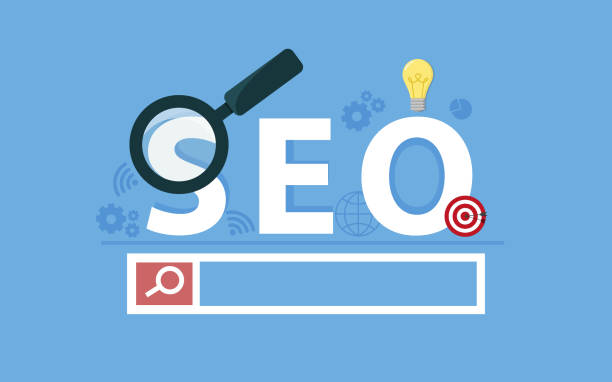Familiarity with SEO Principles: Why SEO is Crucial for Your Business

In today’s digital world, online presence isn’t limited to just having a website.
For your website to be seen and attract targeted audiences, you need a powerful strategy called SEO.
SEO, or Search Engine Optimization, is a set of techniques and strategies aimed at improving a website’s ranking in the organic results of search engines like Google, Bing, and Yahoo.
When a user enters a phrase in #search engines, complex search engine algorithms examine hundreds of factors to show the most relevant and high-quality results to the user.
The main goal of SEO is to make your website understandable and valuable to these algorithms.
The importance of SEO goes beyond mere visibility.
SEO helps you attract Organic Traffic; traffic that comes to your website through user searches and, due to the user’s genuine interest in the topic, has a much higher quality.
This type of traffic, unlike paid advertising, is free and will be more sustainable in the long run.
A website with strong SEO not only attracts more visitors but also gains more credibility and trust in the eyes of users and search engines.
This explanatory and educational section will help you gain a deeper understanding of the vital place of SEO in online success.
Without SEO, your business will be like a shop in a dead-end alley that no one knows about.
Therefore, investing in website optimization is a necessity, not a choice.
Are you disappointed with the low conversion rate of your online store?
Rasaweb is your definitive solution with professional e-commerce website design!
✅ Increase your sales and revenue
✅ Unparalleled user experience for your customers
⚡ Get a free consultation now!
On-Page SEO: Key Elements and Their Impact

On-Page SEO refers to all actions you perform within your website to improve its ranking in search engines.
These actions include optimizing content, page structure, and HTML codes.
One of the most important elements in On-Page SEO is keywords.
Researching suitable keywords and strategically using them in headlines, body text, meta descriptions, and image titles is crucial for visibility in searches.
However, merely repeating keywords is not enough; you must produce high-quality content relevant to the user’s needs that naturally incorporates keywords.
The page title (Title Tag) and meta description are the first things users see in search results.
These elements should be attractive, contain primary keywords, and be enticing to encourage users to click on your link.
Using Heading tags (H1, H2, H3, etc.) for organizing content and improving readability is also highly important.
These tags help search engines understand your content structure.
Optimizing images through appropriate file naming, using descriptive Alt Text, and compressing them to reduce size helps page loading speed and improves user experience.
Your content should be specialized and guiding to satisfy not only search engines but also users.
The more valuable your content is to the user, the longer they will stay on the site, sending more positive signals to search engines, which in turn helps improve your SEO ranking.
On-page optimization is the foundation of any successful SEO strategy, and without it, other efforts may be fruitless.
Technical SEO: Site Speed and User Experience

Technical SEO deals with the technical aspects of your website that affect its crawlability and indexing by search engines.
Website loading speed is one of the most important technical factors.
Today’s users expect pages to open quickly and in case of slowness, they will easily leave the site.
Search engines also attach great importance to site speed and prefer faster sites.
Image optimization, code compression, using CDN (Content Delivery Network), and choosing suitable hosting are among the solutions for increasing speed.
This analytical and explanatory section helps you understand the technical complexities.
The site structure should be logical and understandable so that search engines and users can easily navigate it.
Using a meaningful URL structure, an XML Sitemap to guide search bots, and a robots.txt file to control bot access to different parts of the site are crucial actions in technical SEO.
Mobile-Friendliness is also highly important; given the significant increase in mobile usage for searching, Google prioritizes sites that offer a good mobile user experience.
Implementing an SSL certificate (HTTPS) for website security not only attracts user trust but is also a ranking factor for SEO.
In the table below, you can see the important factors in technical SEO and their impact:
| Technical Factor | SEO Impact | Description |
|---|---|---|
| Site Loading Speed | High | Increases user satisfaction and search engine ranking. |
| Mobile Responsiveness | High | Essential for mobile ranking and user experience. |
| HTTPS Security | Medium | Google ranking factor and increases trust. |
| URL Structure | Medium | Helps content understanding and navigation. |
| XML Sitemap | Medium | Guides bots to discover pages. |
| Robots.txt | Medium | Controls search bot access. |
Ignoring technical aspects can severely damage your SEO performance, even if you have excellent content.
Off-Page SEO: The Power of Backlinks and Social Signals

Off-Page SEO refers to all actions performed outside your website that affect its ranking in search engines.
The most important and powerful element in off-page SEO is backlinks.
A backlink or inbound link is a link from another website pointing to your website.
From the perspective of search engines, every quality backlink is a vote of confidence for your website.
The more quality and relevant backlinks you have, the higher your Domain Authority (DA) increases, which significantly helps improve your ranking in search results.
This specialized section requires a deep understanding of the link-building ecosystem.
The quality of backlinks is much more important than their quantity.
One backlink from a reputable website relevant to your field of work is worth far more than hundreds of backlinks from spammy and irrelevant sites.
Building natural and high-quality backlinks requires strategies such as producing valuable and shareable content, establishing relationships with bloggers and influencers, and publishing sponsored articles on reputable sites.
Activity on social networks is also of particular importance.
Although social signals are not directly an SEO ranking factor, they can indirectly impact SEO.
For example, sharing your content on social networks can lead to increased visibility and, consequently, attract more natural backlinks.
Another aspect of off-page SEO is online branding and reputation.
The more recognized your brand is and the more people search for it, the more search engines consider it a credible source.
Participating in relevant online forums, posting comments on blogs, and engaging in online discussions can also help increase visibility and attract quality backlinks.
Finally, off-page SEO is a continuous process that requires patience, effort, and a precise analytical approach.
The impact of this part of SEO on your ranking can be significant.
Are you dissatisfied with the low conversion rate of visitors to customers on your e-commerce site?
Solve this problem forever with professional e-commerce website design by Rasaweb!
✅ Significant increase in conversion rate and sales
✅ Create an excellent user experience and build customer trust
⚡ Get a free consultation!
Content Strategy for SEO: Attracting Users and Search Engines

Content is king, and in the world of SEO, this principle holds true more than ever.
A strong content strategy not only helps attract users but also shows search engines that your website is a credible and valuable resource for topics related to your business.
Producing high-quality, relevant, and comprehensive content is the foundation of any successful SEO strategy.
This content should answer user questions, solve their problems, and provide explanatory and educational information.
Different types of content are available for SEO, and each can serve a specific purpose.
Blog posts, comprehensive guides, infographics, videos, podcasts, case studies, and even entertaining content can all help improve your ranking.
It’s important that your content is unique, up-to-date, and adds value for the user.
Thought-provoking content can increase user engagement and send positive signals to search engines.
Also, optimizing content for Long-tail keywords can help you attract more targeted traffic that is more likely to convert into customers.
Regularly updating old content and publishing new and news-worthy content also shows search engines that your website is active and dynamic.
Search engines love fresh content and give it importance in ranking.
Furthermore, optimizing content for readability and user experience (UX) is also very important.
Using short paragraphs, subheadings, lists, and relevant images makes your content more appealing to readers and increases their time on the page.
These factors directly affect your SEO.
Ultimately, a comprehensive content strategy not only helps improve your ranking but also makes you a reference in your field of activity, which in turn leads to increased organic traffic and long-term success in SEO will be achieved.
Keyword Research: The Foundation of Every Successful SEO Campaign

Keyword research is the first and most crucial step in any SEO campaign.
Without identifying the words and phrases your target audience uses in search engines, all your subsequent efforts may be ineffective.
The goal of keyword research is to find words and phrases that have both a suitable search volume and manageable competition, so you can rank for them.
This is a specialized and analytical process that requires precision and the use of appropriate tools.
The steps of keyword research include brainstorming initial ideas, using tools like Google Keyword Planner, Ahrefs, Semrush, or even Google Suggest for finding relevant keywords, and analyzing competitors to understand the keywords they rank for, will be included.
It’s important to consider both short, highly competitive keywords (Short-tail keywords) and longer, more specific keywords (Long-tail keywords).
Long-tail keywords have lower search volume but are usually more targeted and have higher conversion rates.
After compiling a list of keywords, you should analyze them for User Intent.
Is the user looking for information? Do they intend to buy? Or are they looking for a specific website? Understanding user intent helps you create content that precisely meets their needs, which in turn helps improve your SEO ranking.
Also, examine the competition level for each keyword.
Some keywords may have high search volume, but the competition is so high that ranking for them will be difficult.
Focusing on keywords with moderate competition and acceptable search volume can yield better results.
Keyword research is not a one-time process; the market and user behavior are constantly changing.
Therefore, you should regularly update your keyword research and add new keywords to your SEO strategy.
This guide provides a comprehensive start to keyword research and plays a fundamental role in determining the overall success of your SEO campaign.
Measuring SEO Success: Key Performance Indicators and Data Analysis

One of the most important aspects of any digital marketing strategy, including SEO, is the ability to measure and analyze its performance.
Without accurate measurement, you cannot understand what works, what doesn’t, and how you can improve your strategy.
Measuring SEO success involves monitoring Key Performance Indicators (KPIs) and analyzing data from tools like Google Analytics and Google Search Console.
This analytical and guidance section provides a deeper understanding of the impact of your SEO actions.
Some of the most important KPIs in SEO include:
- Organic Traffic: The number of visitors who came to your site through natural search results.
This is the primary measure of success in SEO. - Keyword Ranking: The position of your pages for target keywords in search results.
- Click-Through Rate (CTR): The percentage of users who clicked on your link after seeing it in search results.
This indicates the attractiveness of your title and meta description. - Bounce Rate: The percentage of users who left a page without interacting with other pages on the site after visiting it.
A high bounce rate can be an indicator of irrelevant content or poor user experience. - Dwell Time: The amount of time users spend on a page.
Longer dwell time indicates greater user satisfaction with the content. - Leads or Conversions: The number of users who performed your desired actions (such as filling out a form, purchasing a product, or signing up).
This is the ultimate business success metric.
Using Google Search Console provides you with valuable information about how your site appears in search results, the keywords users find you with, and any crawl errors.
Google Analytics also helps you monitor user behavior on your site and gain valuable insights into traffic sources, page popularity, and conversion paths.
These analyses allow you to optimize your SEO strategy and focus on actions that yield the highest returns.
The table below shows the difference between Google Analytics and Google Search Console:
| Feature | Google Analytics | Google Search Console |
|---|---|---|
| Main Focus | User behavior on site | Site performance in search results |
| Main Data | Page views, duration, bounce rate, traffic sources | Keywords searched, CTR, position, crawl errors |
| Primary Use | Optimizing user experience and conversion | Optimizing search visibility and fixing technical issues |
Continuous monitoring and analysis of data is an integral part of a successful SEO strategy that helps you make data-driven decisions.
Common SEO Mistakes and How to Avoid Them

On the path to optimizing a website for search engines, individuals and businesses often make mistakes that can severely damage, rather than improve, their ranking.
Understanding these common SEO mistakes and knowing how to avoid them is crucial for a successful strategy.
This guide is to help you prevent issues that can jeopardize your SEO results.
One of the biggest mistakes is Keyword Stuffing.
This means using keywords excessively and unnaturally in the text, which not only reduces content readability but is also recognized as a spam technique by Google’s algorithms and leads to website penalties.
Instead, focus on high-quality, relevant content that naturally uses keywords.
Another common mistake is ignoring User Experience (UX).
If your website is slow, doesn’t display correctly on mobile, or is difficult to navigate, users will quickly leave it.
This increase in bounce rate and decrease in dwell time sends negative signals to search engines.
Always prioritize optimizing for the user.
Producing duplicate or low-quality content is also a grave error.
Duplicate content or content that offers no added value will not only fail to rank well but can also harm your site’s credibility.
Instead, produce specialized, unique, and high-quality content that fully addresses user needs.
Ignoring technical SEO, such as crawl errors, broken links, or lack of an SSL certificate, can prevent search engines from correctly indexing your site.
Ensuring the technical health of your website through tools like Google Search Console is essential.
Finally, buying backlinks or using spammy links can lead to manual Google penalties.
Backlinks should be acquired naturally and from reputable sources.
Avoiding these common mistakes will help you maintain a sustainable and effective SEO strategy and get the best return on your SEO investments.
This educational section is for everyone who wants to avoid common problems in SEO.
Are you dissatisfied with the low conversion rate of visitors to customers on your e-commerce site?
Solve this problem forever with professional e-commerce website design by Rasaweb!
✅ Significantly increase visitor-to-customer conversion rate
✅ Create an excellent user experience and build customer trust
⚡ Get a free consultation!
The Future of SEO: AI, Voice Search, and Beyond

The world of SEO is not static and is constantly evolving.
Search engine algorithms are becoming smarter, and with technological advancements, the future of SEO will undergo major changes.
Understanding these trends and preparing for them is crucial for any business that wants to succeed online.
This news and analytical section gives you a deep look at the horizons ahead in SEO.
One of the most important trends shaping the future of SEO is Artificial Intelligence (AI) and machine learning.
Algorithms like Google RankBrain and BERT show how much Google has advanced in better understanding user intent and the complexities of natural language.
This means that merely repeating keywords is no longer enough; your content must truly answer user questions and provide comprehensive and accurate information.
Focusing on semantics, not just keywords, will become highly important.
Voice Search is another significant change.
With the increasing use of voice assistants like Siri, Google Assistant, and Alexa, the way users search has changed.
People use longer, more natural phrases when speaking.
Optimizing for voice search means focusing on long-tail keywords, conversational questions, and direct, concise answers.
In addition, Visual Search and Augmented Reality (AR) are also emerging and have great potential to change how users interact with content.
Optimizing images with appropriate Alt Text and structured data can help businesses be seen in these areas as well.
Local SEO will also continue to grow in importance with the increasing prominence of “near me” searches and location-based businesses.
Finally, User Experience (UX) will always remain at the center of SEO.
Fast, responsive, and user-friendly sites will always be prioritized by search engines.
These trends indicate that SEO is moving more than ever towards providing the best possible user experience and a deeper understanding of their intent.
Preparing for these changes will put you at the forefront of competition in the future of SEO.
This is an entertaining opportunity to explore new frontiers in SEO.
Local SEO: A Guide to Visibility in Local Searches

For many businesses, especially those offering services or products in a specific geographical area, Local SEO is of vital importance.
Local SEO refers to the process of optimizing your online presence to attract customers from local searches.
For example, if someone searches for “Italian restaurant in Tehran”, local SEO helps your restaurant appear in the top results.
This section is a comprehensive guide to mastering this important aspect of SEO.
The first and most important step in Local SEO is creating and optimizing your Google My Business (GMB) profile.
This free profile allows your business to appear in Google Maps and Google’s local search results.
Ensure that all your business information – Name, Address, Phone Number (NAP), opening hours, images, and descriptions – is accurate and complete.
Requesting and responding to customer reviews in GMB is also very important, as positive reviews and actively responding to them build user and search engine trust.
NAP (Name, Address, Phone Number) citations across the web also play an important role.
Ensure that your business information is consistent and accurate across online directories, review websites, and other platforms.
Inconsistent information can send negative signals to search engines and harm your local SEO ranking.
Using local keywords in your website content is also important.
For example, if you provide plumbing services, use phrases like “Tehran plumber” or “pipe repairs in District One”.
Creating separate pages for each location or branch (if applicable) can also help improve local SEO.
Finally, local link building and acquiring backlinks from reputable local websites, such as the chamber of commerce or local media, can increase your credibility in the area.
Local SEO is a powerful strategy for attracting potential customers near you and can directly impact the sales and profitability of physical businesses.
This is a specialized approach that requires attention to geographical details.
Frequently Asked Questions
| Question | Answer |
|---|---|
| What is SEO? | SEO, or Search Engine Optimization, is the process of increasing the quality and quantity of website traffic by improving the site’s ranking in organic search engine results like Google. |
| What are the main types of SEO? | SEO is divided into three main categories: On-Page SEO, Off-Page SEO, and Technical SEO. |
| What does On-Page SEO include? | On-Page SEO includes optimizing elements within the website, such as keywords, Title Tag, Meta Description, content, URL structure, images, and internal links. |
| What is Off-Page SEO? | Off-Page SEO refers to activities outside the website that help improve its ranking, such as Backlink Building, social media marketing, and Brand Mentions. |
| What is Technical SEO? | Technical SEO deals with optimizing the technical aspects of a website to help it be better crawled and indexed by search engines. This includes site speed, mobile-friendliness, site structure, Sitemaps, and Robots.txt file. |
| What role do Keywords play in SEO? | Keywords are phrases users enter into search engines. Proper and targeted use of relevant keywords in content and site elements helps search engines understand your page’s topic and display it for relevant searches. |
| What is a Backlink and why is it important? | A backlink or inbound link is a link from one website to another. Backlinks act as a “vote of confidence” from other sites for search engines and play an important role in the site’s credibility and ranking increase, especially if they are from reputable sites. |
| What effect does quality content have on SEO? | Quality, relevant, comprehensive, and unique content not only attracts and retains users but also shows search engines that your page is valuable. This helps improve ranking, reduce Bounce Rate, and increase user dwell time on the site. |
| Why is site loading speed important for SEO? | Site loading speed is an important ranking factor for Google. Faster sites provide a better user experience, have lower bounce rates, and are preferred by search engines. |
| Is SEO a one-time process? | No, SEO is a continuous and long-term process. Search engine algorithms are constantly changing, competition is increasing, and site content also needs updating. Therefore, SEO requires continuous monitoring, analysis, and optimization. |
And other services of Rasaweb Advertising Agency in the field of advertising
Smart Link Building: An effective tool for digital branding by precisely targeting the audience.
Smart Direct Marketing: An exclusive service for improving SEO ranking based on attractive UI design.
Smart Marketing Automation: Designed for businesses seeking user engagement through intelligent data analysis.
Smart Sales Automation: Professional optimization to increase sales using attractive UI design.
Smart Brand Identity: A new service to increase click-through rates through precise audience targeting.
And over a hundred other services in the field of internet advertising, advertising consultation, and organizational solutions
Internet Advertising | Advertising Strategy | Advertorial
Sources
- Comprehensive SEO Guide on Virgool
- SEO Training on Mojila
- What is SEO? on Rastinweb
- Complete SEO Training by MihanWP
💭 In today’s competitive world, a powerful online presence is the key to success. Rasaweb Digital Marketing Agency, by providing comprehensive services including fast website design, SEO, and social media management, elevates your business to new heights. For a free consultation and to learn more about our services, contact us today. 021-91097325
📍 Tehran, Mirdamad Street, next to Bank Markazi, Kazerun Jonubi Alley, Ramin Alley, No. 6
☎️ 02126406207



